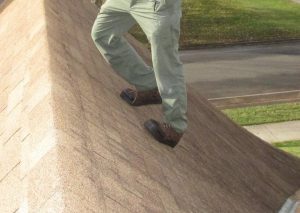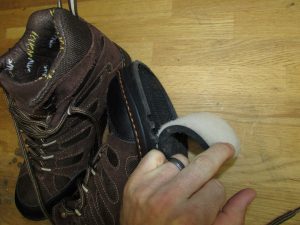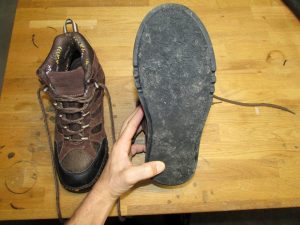For anyone in any type of business who regularly walks sloped roofs, I recommend getting a pair of boots that are made for the job. They’re called Cougar Paws, and they’re not your everyday work boot; they’re designed specifically for walking sloped roofs, and the bottoms are made from the same stuff that Spider-Man has on the bottom of his feet.

After just one use on an asphalt shingle roof, you’ll swear you’re Spider-Man. I’ve been using the Cougar Paws Estimator Boots for just over a year now, and I’m completely sold on them. They make tougher versions of this boot, but I don’t need them for home inspections.
When to use them
I suppose it would be safest to use these boots every time a roof is walked, but let’s be honest, switching shoes takes time. Nobody who walks roofs as part of their profession is going to bat an eye at a 4:12 or even a 6:12 roof; heck, I’d feel comfortable walking those roofs in dress shoes. Maybe.
Side note: roof slope, aka pitch, is measured in rise over run. For example, a roof with a 6:12 pitch will have 6″ of rise for every 12″ of run, making for a 22.5 degree incline. A 12:12 roof will have a 45 degree incline. To determine roof pitch, check out Pitch Gauge, a free app for Android or iPhone.
For slopes greater than 6:12, Cougar Paws are worth the time it takes to switch shoes. Just for the heck of it, I tried these shoes on a 12:12 roof the other day, and I scampered right up without any problem. I wouldn’t normally climb a roof with that pitch, but I had a lower sloped roof below me, along with a big masonry chimney right behind that for insurance. The limiting factors for roof pitch safety will probably come down to ankle flexibility, personal comfort, and the condition of the roof. My personal policy is to only walk roofs when I’m sure it’s safe to do so.
Traction grip technology
I don’t know what the bottoms of these boots are really made from, but it seems to be a piece of heavy duty foam held in place with a hook-and-loop system. The Cougar Paws website calls them Peak Line Replacement Pads, and they claim these pads provide performance on shingles, plywood, wood shakes, felt, and slate.
After using these boots to walk steeper roofs for the past year, I’m beginning to see some wear on the bottoms of my replaceable pads.
I’ll probably need to order some new pads in another year or two. They go for $15.95 online. The boots, on the other hand, will probably outlast any pair of boots or shoes that I’ve ever owned because I only wear them for short periods of time.
Sizing
They say right on the Cougar Paws website that men should order these boots in their normal shoe size and that women should order two sizes smaller. I tried ordering my normal shoe size and my foot was swimming in this boot, so I went one size smaller and that fit nicely. Several of the inspectors in my company have these boots, and they all use one size smaller, so my advice is to ignore the advice on their website and order one size smaller. Perhaps women should order three sizes smaller.
Summary
If you walk roofs, get yourself a pair of Cougar Paws. At around $150, they’re not cheap, but they’re nice boots that will last a long time. If they save you from just one fall, it’ll be some of the best money you’ve ever invested. I’ve had another home inspector tell me that broomball shoes work very well on roofs too, but I’ve never tried them myself.



Bill Vicaire
November 3, 2016, 7:59 pm
I would love to have a pair of these but they do not appear to make “high tops”. I need them for the snow here in the Northeast and I’m not much of a fan of the strap on sole type. They leave potentials for which I would rather not have. I’ll keep an eye on this company though and get a pair if they decide to make the high top type I desire.
I do thank you though for the recommendation.
Happy inspecting!
Take care,
Rich P
December 13, 2016, 7:10 pm
Minor correction on your side note: One might think that since a 12:12 pitch is a 45 degree angle and a 6:12 pitch is half as steep that the 6:12 would be 22.5 degrees. It’s actually 26.57 degrees. I found that out the hard way after cutting a bargeboard with a miter saw.
Reuben Saltzman
December 14, 2016, 5:02 am
I see. Why is that?